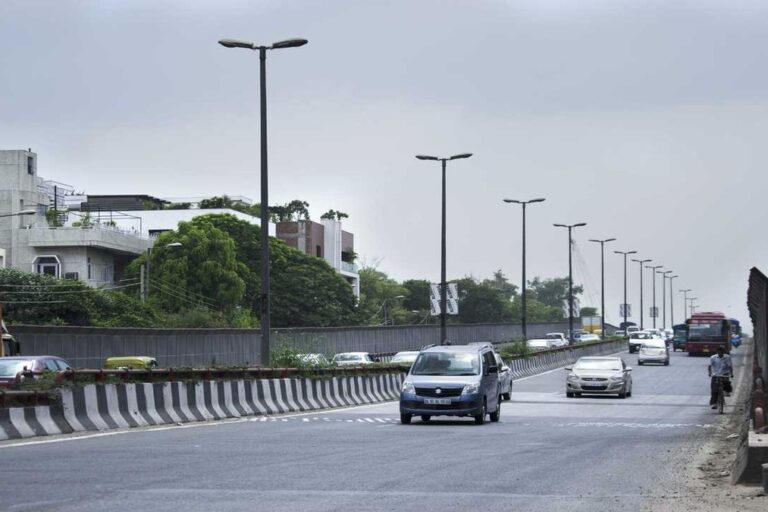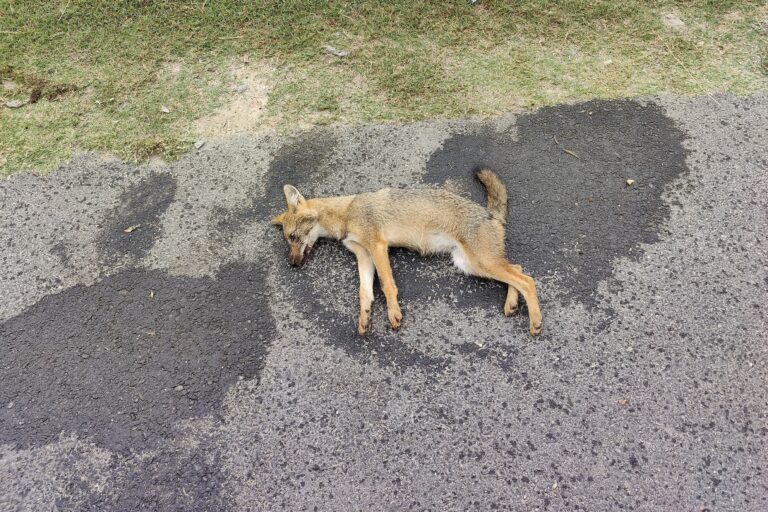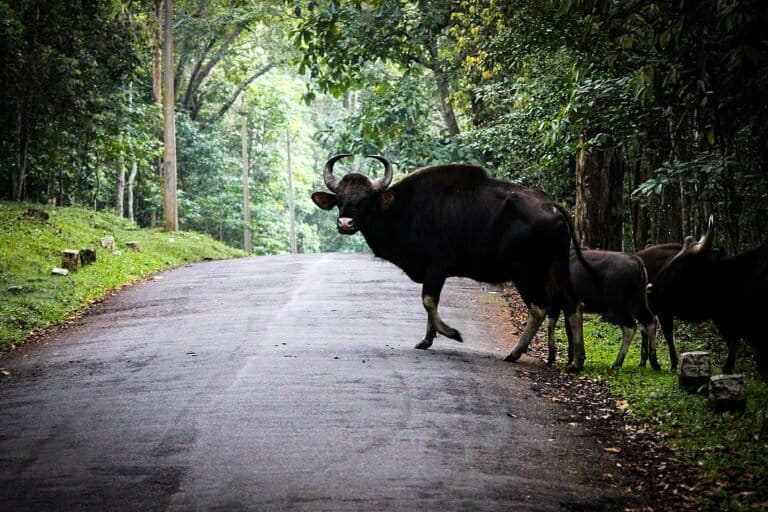- Felids and canids are noted to be the most common victims of roadkill, among other nocturnal vertebrates on roads constructed in northwestern Himalayas.
- The number of vehicles on roads in Jammu and Kashmir have increased by 100% since 2014, while four new national highways have been constructed.
- Several critically endangered and near threatened species are falling victim to vehicular collisions, including leopards, monkeys, mongoose, amphibians and reptiles.
- Careless dumping of garbage on roadsides is a contributing factors to increasing instances of roadkill.
In September 2011, a team of researchers from the Institute of Mountain Environment (IME), University of Jammu, found a pair of jackals dead on the Jammu-Poonch national highway. “Sadly, the female was pregnant. The incident continues to haunt me. In the following years, we have observed a steady rise in such horrific road accidents involving wild animals such as monkeys, langurs, mongoose, squirrels, foxes, leopards, birds, reptiles etc.,” shares wildlife researcher Neeraj Sharma, who was part of the IME team that was out for a field survey on that day.
Wildlife roadkill is a significant problem in the northwestern Himalayas in India, a global biodiversity hotspot that is home to the leopard, the critically endangered hangul or Kashmir stag, brown bear, the near threatened markhor and Himalayan griffon, among other species.
As vehicular traffic increasingly chokes roads that pass through or near wildlife habitats, the number of animals killed or injured after collisions, has been on the rise. According to the Jammu and Kashmir Traffic Police, Jammu and Kashmir had 6,68,445 vehicles in 2008, with the number rising in the following years. In 2010, 2011 and 2012, vehicle numbers increased by 10.34%, 11.92% and 11.98% respectively, with 2012 recording 9,16,898 vehicles. Around 14 lakh vehicles are registered in Jammu and Kashmir as of 2022, indicating 100% increase in the last 14 years. Simultaneously, the number of National Highways in the union territory has increased from seven in 2014 to 11 in 2021, after Rs. 40,900 crores worth of infrastructure projects were announced in 2015.

Felids and canids at highest risk on roads
Amid growing vehicular traffic especially on highways, smaller carnivores such as red foxes and golden jackals most often observed as victims of vehicle collisions. With increasing roads and traffic, their deaths have increasingly become more frequent now, observe wildlife experts.
Intesar Suhail, Wildlife Warden of Shopian district in South Kashmir observed that the recently constructed stretch of a National Highway passes through Qazigund town, which is surrounded by paddy fields that offer a good cover to smaller animals, including foxes and jackals during its crop season in September and October. “The jackals and foxes are always on the move in search of shelter, food or a mate. However, the road can act as a barrier and has to be crossed to get access to critical resources. Jackals and foxes avoid midday and tend to cross the road during dusk or night. That’s why we witness most of their killings during the night. Also, the headlights of the vehicles can have a blinding effect on the mammals resulting in their death.”
In September last year, the International Journal of Ecology and Environmental Sciences published a study conducted by researchers from University of Kashmir on roadkill patterns on a 45 km stretch of the Srinagar–Leh National Highway from March to August 2019. The highway traverses through Sindh Valley in Central Kashmir and passes adjacent to Thajwas Baltal Wildlife Sanctuary.
The six-month survey recorded roadkill of 64 individuals comprising 19 vertebrate species. An average of 10.6 kills per month were recorded during this time, largely golden jackals and red foxes.

“Mammals constituted 37.5%, followed by birds (24%), reptiles (21%) and amphibians (17%). Excluding amphibians and reptiles, there was significantly more roadkill on road sections adjacent to the protected areas (59%) than in sections adjacent to non-protected areas,” the study stated.
In another study on wild animal roadkill due to vehicular collision, the team of researchers conducted surveys on roadkill for 33 months on the mountainous National Highway 244 in Jammu and Kashmir, connecting Batote (Jammu) to Kashmir Valley. The findings published in 2022 showed that 49 carcasses of 13 species of higher vertebrates were recorded on the road, shoulders, edges, and valley slopes. These included seven mammals, four birds, and two reptiles.
Neeraj Sharma, a co-author of this study, said the animal carcasses observed indicated that these species were struck or overrun by speeding vehicles at night, as most were nocturnal.
“During the night, animals can be seen roaming around the marketplaces and rubbish dumps in search of food. Predators make their way down the mountainside in search of water and food sources. As a result, these animals are victims of reckless driving. Our study found that mammals are affected more than other taxa, mostly including nocturnal animals,” he said.
“The literature on road-related wildlife fatalities suggest that all animals are prone to become roadkill, but nocturnal animals, particularly felids and canids, are more vulnerable,” Sharma added.
The study also revealed a major roadkill cluster around a small township, which was theorised to be caused by the presence of open waste dumping site on the side of the road and a water channel, both frequented by wildlife for food and water, making them vulnerable to vehicular collisions.
Read more: [Interview] Researcher Amit Kumar Bal on studying carnivores in the thick of Mizoram forests
Impacts of roads
Bivash Pandav, a scientist at Wildlife Institute of India, talking about the impact of roads on wildlife mortality, particularly noticeable when they are large herbivores or carnivores, said, “We have an example of Asiatic cheetah in Iran. Over the past 60 years, Iran has been home to the last known population of Asiatic cheetahs, which once roamed across vast ranges of the west and south Asia, from the Middle East to India. Listed as ‘critically endangered’ by the IUCN, the Asiatic cheetah is among the rarest cats in the world at the subspecies level, with fewer than 50 believed to remain in Iran. They can only be found in the rugged mountain terrains. The biggest factor for their decline is the roads that fragment their habitats.”
Anup Prakash, a wildlife biologist at The Habitats Trust notes that indirect impacts of roads on wildlife are usually more difficult to measure and address.
“They occur when a road changes a natural or social environment which in turn leads to negative impacts. For example, roads are known to facilitate increase in illegal human activities like hunting and poaching, deforestation, spread of invasive species, intensive farming, altering the microclimate near roads,” Prakash said.

A review on the impact of roads in sub-Saharan African ecosystems revealed that accessibility to ecosystems provided by roads influenced land use patterns, along with illegal hunting and harvesting. In the Republic of Congo, studies showed that logging roads – even subject to anti-poaching controls – were exploited by elephant poachers and had a major negative influence on elephant and chimpanzee distributions.
“In India, with its small-sized protected areas and restricted populations of endangered animals, roads may act as direct conduits for poaching by people who do not connect with a landscape the way native people may do,” Prakash said.
Roads also act as an ecological trap, when animals are drawn to falsely attractive ‘habitats’. “For example, a whole food chain gets set up on the roads when extremely tiny insects are attracted to vehicle lights due to which they die in millions. This might attract lakhs of frogs and snakes that are carnivorous who also end up dying on the roads. Their carcasses further attract the bigger reptiles and birds etc making them susceptible to roadkill. Thus, an ecological trap is set up wherein in a lot of local extinction happens in and around the road,” Prakash detailed.
Tourism and garbage as contributing factors
“The tourist influx particularly on the Pahalgam-Aru road in South Kashmir has increased manifold. Last year in autumn, our team spotted a carcass of Kashmir flying squirrel on the road. Endemic to Kashmir and some Western Himalayas like Himachal Pradesh and Uttrakhand, it is a nocturnal animal,” Suhail said. He added the squirrel is arboreal and rarely leaves the tree tops as it can glide easily between them. “Its carcass was evidence of how traffic on this initially inaccessible area has increased.”
A huge tourist inflow is also being witnessed along the Srinagar-Leh highway. Sonmarg and Leh are two highly frequented places by travellers.
“During their travel, they carry chips packets and other eatables. If not disposed properly, the leftover food will attract wild animals. They may tend to avoid the road initially but are drawn to food resources like garbage as they become more available. In this process, they get killed. The garbage will surpass all other limitations and will draw the animals towards the roads. Also, almost all animal species exhibit the same kind of behaviour when it comes to feeding on garbage,” Pandav added.

A recent study conducted by Wildlife SOS explained the challenges posed by garbage to critically endangered Himalayan brown bears, whose population has been steadily declining in the past century with only an estimated 500-750 bears left in the country.
According to the study, more than 75% of a brown bear’s diet is scavenged from garbage. This was noted through excreted plastic carry bags, milk powder, chocolate wrappers, and biryani.
“The kitchen waste generated by hotels especially in tourist spots is not disposed properly and they dump it off by the side of the road, attracting the brown bears. Fortunately, we haven’t had any report of vehicle hits as far as brown bear is concerned. Nevertheless, there needs to be a proper garbage disposal mechanism in place,” Suhail said.
Nomadic communities and roadkill
The nomadic community of Jammu and Kashmir (Bakerwals) moves along Mughal road in South Kashmir during spring and late autumn. During their transit, animals from their livestock die, especially if there is a heavy snowfall or sudden thundershowers. The migratory herders leave the carcasses of the dead animals on the road which eventually attracts vultures, which are hit by vehicles while they feed. Mughal road passes through the Hirpora Wildlife Sanctuary, which is a home to vulture breeds like Himalayan griffon vulture and bearded vulture, both noted as near threatened.
“As a management intervention, my team patrols the road along Hirpora every morning, removing carcasses, which are dumped in safe places where vultures can feed without getting hit. We have managed to save many vulture lives through these efforts,” Suhail said. He added that such type of activities should also be taken up on other roads like Sinthan Top in South Kashmir and Razdaan pass in North Kashmir which are used by Bakerwal tribes. “These areas are a home to many other high-altitude birds like vultures,” he stressed.
Mitigation measures
While roads are important for connectivity, the risk they pose to wildlife must be considered. Urban planners must ask – who needs a road?

“For example, if a road is constructed for a single time use of a project — it can be a windmill project or a solar power project or building a dam. In this case, the road can be made temporary. If the road is serving a big town in which case, there are some models that can be adopted. For instance, two roads to Ooty and Kozhikode pass through the Bandipur Tiger Reserve. Karnataka government launched the night travel ban for the first time in 2009 in these roads to avoid the then recurring cases of accidents and animal deaths during night. After launching the night ban, alternative routes were developed that mostly avoided the forest, which increased the travel time but was a worthy trade-off in the long run,” Prakash said.
One also has to understand that animals move in fixed patterns. Wildlife biologists must identify them correctly while roads are being planned. “This can be done based on in-depth studies carried out at least one year before the initiation of the project,” Pandav said. He added that we must also find out the areas which contain critical resources like water, mineral licks, various types of vegetation that animals may depend on at different times of the year. “Such resources need to be identified in the area vis-à-vis the movement of the animals. This can further help in taking appropriate conservation measures.”
In addition to this, camera traps and radio-collars can help get a good idea about their fine scale movement. “If they are critically endangered animals like Hangul and Markhor, they need more careful supervision. Use of technology is a must in furthering our understanding about the movement of animals,” said Pandav.
In a time when highway expansions are being planned widely, scientifically based mitigation measures are a necessity. “These include construction of wildlife passages at vulnerable sections especially the below-road crossing structures like culverts for larger species and drainage pipes for small size species maintaining a wide field of view for drivers and wildlife, widening shoulders to facilitate wait and go calls, planting caution boards and laying speed breakers near water bodies and dumping sites, sensitizing the drivers, and organizing citizens to build a reliable dataset for better analysis,” Sharma said.
Read more: Helping wildlife navigate road and railway infrastructure
Banner image: A golden jackal at Keoladeo National Park. Representative image. Photo by P Jeganathan/Wikimedia Commons.
